[About this series]
This time, BERD has decided to conduct a cross-national survey in order to examine the development process of the "attitudes of learning to learn (social and emotional skills)" and environments necessary to nurture such attitudes in early childhood. Prior to this survey, researchers from BERD and CRN have visited several ECEC facilities and families in Asia and Europe during the period between 2016 and 2017. They observed and interviewed the actual life-style of parents and children as well as the initiatives of facilities and families to develop the "attitudes of learning to learn." The reports will be on the current conditions of early childhood education, parents and children, and interactions with children in each country through the eyes of the researchers. Please understand in advance that the examples of facilities and families they will describe in this series are meant to introduce the efforts and initiatives they observed during the survey visits and are for reference only. |
Finland, a land of forests and lakes. Our survey team, made up from staff members of the Benesse Educational Research and Development Institute and Child Research Net, visited Helsinki in January. The trees were leafless and the lakes all frozen. The maximum temperature was around 0℃ even on so-called "warm" days. On the other hand, indoors was so warm that we could remain short-sleeved. We were in Helsinki for three days and visited two daycare centers, two neuvola (maternity and child health clinic, literally translated as "place for advice") facilities, and three Finnish families with children aged 6 or 7 years old. In the home visit survey, we interviewed some mothers to ask them about their children's daily lives, family education and intellectual training, preparation for school enrolment and so on. In this session, we will report on the outcome of our home visit survey.
As for our visits to the daycare centers and the neuvola facilities in Finland, please read "Early Childhood Education in Finland: Esikoulu that Helps the Transition from a Day care Center to Elementary School" and "Japanese version of neuvola: obstacles to introduce neuvola; Vol.2. Our visit to neuvola in Finland (only available in Japanese)", respectively.
1. Children playing cheerfully and freely in the snow; preparation for elementary school at their own pace
Vantaa is located at a distance of about 20 minutes from Helsinki by train. Due to recent urban development, new residential areas have been expanded and more families with small children have migrated into the city. The three families we visited are also living in new townhouses. Our appointment was scheduled for the evening and we walked on the snowy path at dusk to visit each family. Our research project aims to examine the development of children's skills that should be more or less complete prior to elementary school enrolment; thus the home-visit surveys in each country were carried out under the same conditions of interviewing households with children in their pre-elementary year. In Finland, children start school at seven, so we visited families with children aged 6 or 7 years old.
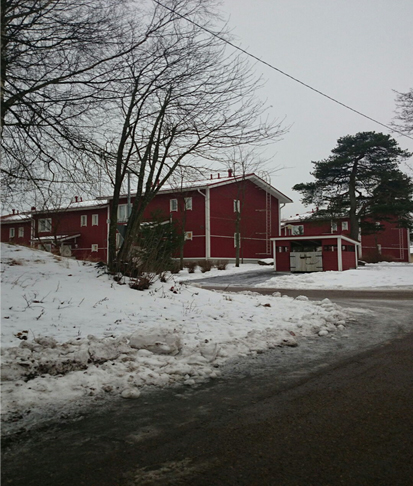
Photo 1: The townhouse exterior
At the entrance door, all members of the family welcomed us. The reason why they asked us to come to their house in the evening was that, in Finland, 80% of mothers with children aged between 3 and 5 years work during the daytime, while their children attend daycare centers*1. In Finland, the working hours per week for men and women are shorter than those of Japan*2. The father had already come home when we arrived there, so he could take part in the interview while also taking care of the children.
At the entrance, they placed their snowsuits and boots in a corner. We were impressed when we realized that in all the Finnish households we had visited, they had clearly delineated the spaces for adults and for children by using independent rooms for children, adults, and for the living room. Unlike the families in Shanghai and Chengdu we visited for the survey, they do not put up educational posters on the wall nor leave any toys in the living room. The living room was styled with a Nordic interior design based on white and natural wood colors, lit with soft ambient illumination; clean and tidy all around. In contrast, the interior designs of the children's rooms were very much to the children's taste, making them cheery and exciting places to be in.
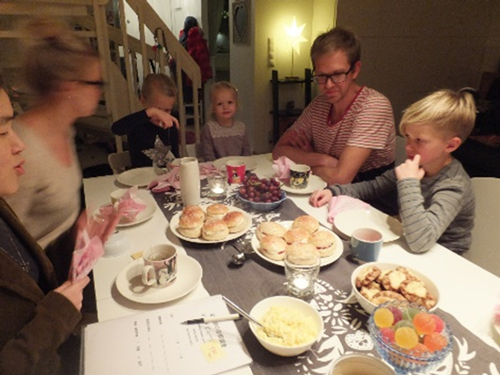
Photo 2: Snapshot of the family scene
Having traditional Finnish bread eaten when skiing, while interviewing the family.
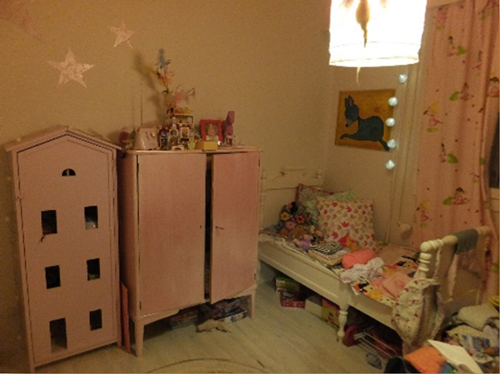 |
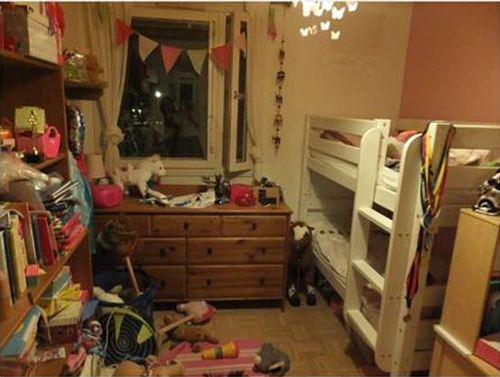 |
|
| Photo 3: Girl's room | Photo 4: Girl's room |
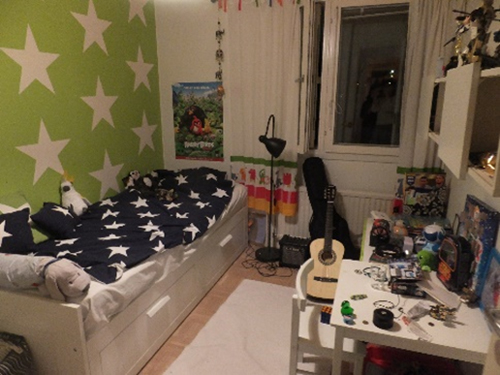
Photo 5: Boy's room
There was one thing I wanted to see while I was in Finland. It was the children's playhouse called Leikkimökki (children's hut). This amazing playhouse is often placed in a family garden, to which children invite their friends over to play. They even sleep there in summer. Some families living in a townhouse share one Leikkimökki built in a common area. Fortunately, I got to see my precious Leikkimökki in the garden of the second family. It was a warm and thoughtful playhouse built by the grandfather of the children. The ceiling was high enough so that children could stand inside, and miniature items of furniture and toys were set inside.
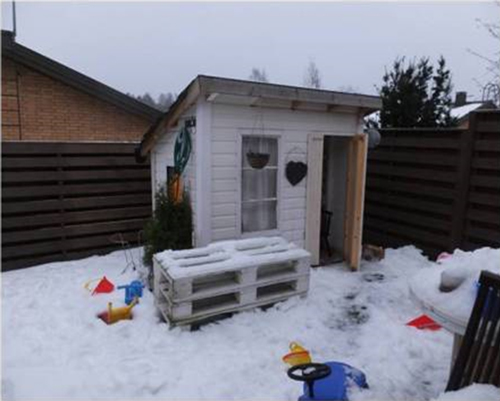
Photo 6: Playhouse "Leikkimökki"
The children of the families we visited attend daycare centers on weekdays until around 16:00 when their mother or father comes to pick them up. After they return home, they will play with their siblings or friends, or go out again for enrichment programs. The popular enrichment programs among children are ice hockey, figure skating, football, swimming, piano, and ballet. There is no cramming school in Finland, but through our interviews, we have noticed that the Finnish parents do not need such schools. When we visited these families, we saw that children wearing snowsuits cheerfully rushed out into the snowy garden even though it was already dark outside.
We saw numerous forests and lakes in Vantaa although this is an urban area. We heard that Finnish families often spend weekends and holidays in the forests picking wild berries and mushrooms, swimming in a lake, or watching movies at home. They sometimes participate in community events for children such as woodwork and carpentry workshops. Some families take a long summer vacation together, driving camper vans and staying near a lake.
In 2003, Finland was ranked first in science and reading literacy in the PISA test (the OECD's triennial survey of 15-year-old students in member countries around the world known as the Programme for International Student Assessment) and is still ranked high among European countries. Then, how do Finnish families support the development of children's cognitive skills such as literacy and numeracy at home? We asked the mothers how they help children prepare to start elementary school, and they replied that they do not make their children prepare for school education, but rather prepare them for commuting to school on their own. So, they need to find friends to commute together as well as establishing methods to communicate with children while commuting to school. None of them provide early education and study training for children to prepare for elementary school, unlike mothers in Shanghai and Chengdu. Instead, a preschool called esikoulu plays an important role in preparing for the transition from kindergarten to elementary school (providing a one-year curriculum free of charge before children start elementary school; more than 90% of Finnish children attend esikoulu). The mothers we interviewed highly appreciated esikoulu, saying that their children learn all things necessary there.
Nevertheless, those mothers make some efforts to provide education for children at home, such as making an alphabet table, downloading learning applications onto tablets and smartphones, etc. All children of the three families were playing with these devices at home. Mothers were not necessarily opposed to children's use of electronic devices, saying that there are more good applications than before, and that their children need to know how to survive in the era of electronic media.
When we asked these mothers about the development of their children's non-cognitive skills, all of them replied that they value the skills "to care about others" (cooperativeness), "to express his/her feelings and thoughts" (self-assertion), and "to acquire social manners/follow rules" (self-control). They do not force children to obtain non-cognitive skills but rather let them learn by themselves in their daily lives.
In this home visit survey, we confirmed that these three Finnish families are raising children through family activities, natural environments and play, nurturing their physical and emotional growth at their own pace.
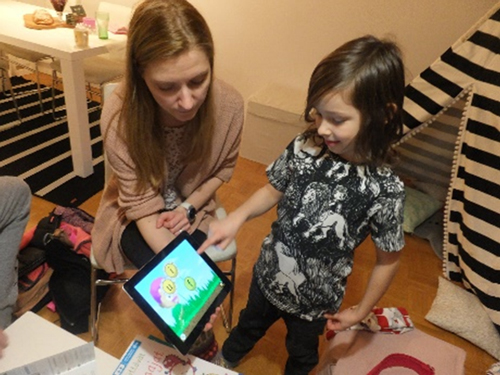
Photo 7: Child touching alphabetical characters on the tablet screen

Photo 8: Alphabet table painted in oils by a mother who loves painting, which is used by her child who became interested in letters
Finland has neuvola, a maternity and childrearing support system for families during pregnancy, at childbirth and with preschool children. Mothers can receive medical checks and advice from health nurses at neuvola during their pregnancy until their children start elementary school. When we asked mothers where they obtain advice and information about childrearing, all of them mentioned neuvola. We were very impressed by such a good system that provides personalized free consulting services for families' mental and physical health as well as essential places for mothers during their pregnancy, childbirth and childrearing periods. In addition, neuvola collaborates with relevant administrative authorities. It will pass any identified issues of children to the authorities, when deemed necessary, including children's physical/mental developmental problems, family problems such as abuse and domestic violence, and economic problems. In this way, neuvola supports parents in their childrearing, identifies children's problems in the early stages, and prepares for a smooth transition to elementary school ages.
2. A work-life balance to support childrearing by parents based on the concept of true gender equality
What struck me most in this home visit survey was the relationship between husband and wife where they equally continue to work and take care of their family in aspects of mental and behavioral settings. The husband and wife answered our interview and pretesting by consulting with each other. While the mother answered our interview, the father played with the children, took them to enrichment programs, made us a light meal, and cleaned up the dishes. The father also knew his children well as he answered our interview questions.
We asked the mothers about the sharing of housework and childrearing with their husbands, and they replied, "Either one of us who can spare the time to do so depending on the situation," "Share tasks in our respective favorite areas" and "Have never thought that I was forced to do housework or childrearing one-sidedly, because husband and wife are equal."
According to the government survey (Figure 1), in contrast, the attitudes of Japanese people towards the equal sharing of household and childrearing tasks do not reach the level of those in Nordic countries, although the Japanese government has implemented various support policies for double income families in an effort to address a society with fewer children. The data was obtained from Sweden, another Northern European country similar to Finland. The survey revealed that more than 90% of men and women in Sweden replied that "Both the wife and the husband take charge," indicating nearly 30 points difference from the scores of Japanese respondents.
| Figure 1. The role of the husband and the wife in rearing children before they go to elementary school | |||||
| Male | Female | ||||
| Japan | Sweden | Japan | Sweden | ||
| Mainly the wife is in charge. | 6.8 | 0 | 9.8 | 0.6 | |
| Mainly the wife is in charge, but the husband also gives a hand. | 52.4 | 5.3 | 57.2 | 4.7 | |
| Both the wife and the husband take charge. | 36.6 | 93.9 | 30.4 | 93.9 | |
| Mainly the husband is in charge, but the wife also gives a hand. | 1.2 | 0 | 0.7 | 0.3 | |
| Mainly the husband is in charge. | |||||
| I do not know. | 3 | 0.8 | 1.9 | 0.6 | (%) |
| total | 336 | 358 | 418 | 342 | |
| Source: International Attitude Survey on Declining Birthrate Society (2015, Children and Child-rearing Administration, Cabinet Office, Japan) | |||||
Meanwhile, the Association for Finnish Work, a Finnish labor-related organization, conducted a survey in Finland in 2014 and announced the results in 2016. In this survey, about 70-90% of the respondents replied that "Both the wife and the husband take charge" for household tasks (cleaning rooms, washing clothes, preparing meals, tidying up, and grocery shopping)*3.
According to Watanabe (2011), Finland's childrearing support system aims to create a society of gender equality in terms of work and childrearing while promoting child welfare, which is different from Japan's support policies that aim to address the issue of declining birthrates. The Finnish support system targets both mothers and fathers. Returning to work after some years of childcare leave is guaranteed by law. Local governments assume responsibility to ensure that all fathers and mothers receive childcare services if they wish to do so. As mentioned above, I have realized, through this home visit survey that the concept of gender equality is truly accepted and practiced among husbands and wives in Finland. This perception and value have been cultivated over the years and deeply penetrated into the fundamental policies of the nation.
In addition, Finland has a well-established work-life-balance culture, such as much less overtime work compared to Japan*4, which enables both husbands and wives to participate in childrearing. The families we visited told us that they rarely need support from grandparents or external individuals/organizations. They said, "We would only ask our parents for help on a few special occasions, such as when my husband and I go out to celebrate our anniversary."
On the other hand, Finland records a high divorce rate (24,708 marriages versus 13,939 divorces in 2015)*5 with various forms of families such as single-parent families (accounting for 10% of the total families with children), step families, and families of de facto couples (the percentage of children of de facto marriages: 40.8%)*6. The "right of children" is protected by law, demanding parents to cooperate in childrearing even after their divorce. Some children live part time with both parents. In this research project, we prepared a common questionnaire list for subject countries. However, for Finland, we needed additional considerations for the definition of families and questions about the actual status of families.
When we were traveling by train and bus, we noticed there were some stations where large numbers of residents of other nationalities and ethnicities got on the train. In Finland, the number of immigrants has been increasing in some regions, which has led to various social issues in the area of public services such as social security, taxes, and education. Therefore, Finland is facing a big challenge to maintain its Nordic social security/welfare systems, while addressing the issues of rights and equality in a society of diversifying family structures and ethnicities. By observing the country, we may find many implications for the future of Japanese society that faces a declining birthrate.
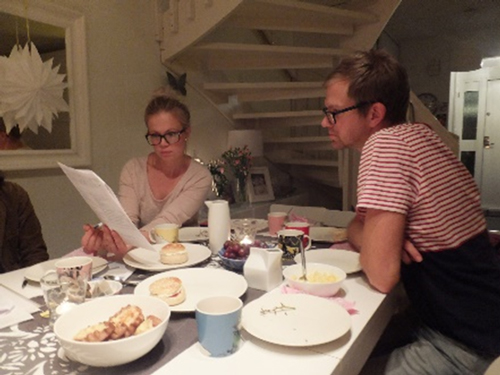
Photo 9: Both husband and wife answered the questionnaire on their children. The mother is working at a neuvola as a health nurse, while raising three children. She has acquired the midwife certification so as to provide more support for pregnant women.
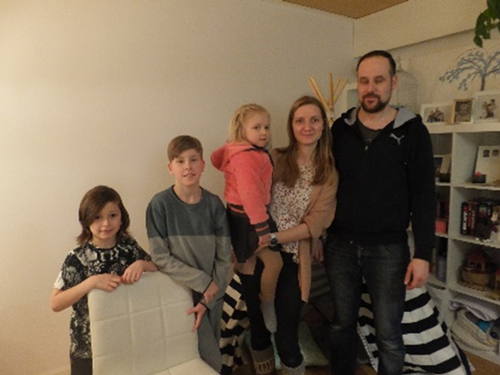
Photo 10: Mother joins the education program for handicapped children at elementary school.
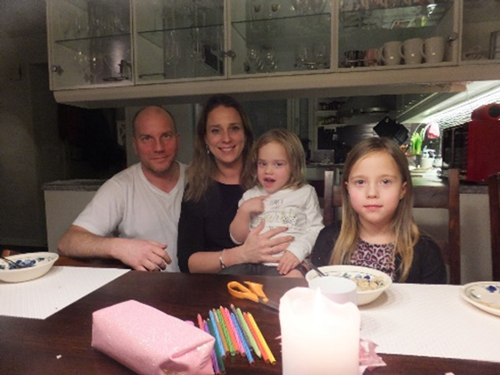
Photo 11: Mother who is an active career woman asked us many questions about double-income families in Japan. She wants her two daughters to be independent and strong and take up a job they like just as their mother.
The original article in Japanese was reviewed by Ms. Kuniko Shimomura. I would like to take this opportunity to thank her for all her help.
References:
- Watanabe, K. (2011). Suweden·Finrando to Nihon no kosodate shien--Shusshouritsu zougen no genin to kekka--[Child Care Support of Sweden, Finland and Japan -- Causes of different birth rates --]. Journal of Aoyama Gakuin Women's Junior College. Vol. 65.
- Children and Child-rearing Administration, Cabinet Office, Japan. (2015). International Attitude Survey on Declining Birthrate Society.
- *1, 2, 4, 6 OECD. (2007). Babies and Bosses - Reconciling Work and Family Life: A Synthesis of Findings for OECD Countries.
- *3 Association for Finnish Work. (2014). SINIVALKOINEN JALANJÄLKI. Retrieved July 13, 2017 from http://suomalainentyo.fi/wp-content/uploads/2016/08/Sinivalkoinen_jalanjalki_raportti-maaliskuu-2016-verkkoon-1.pdf
- *5 Statistics Finland. (2016). Changes in marital status. Retrieved from July 13, 2017 from http://tilastokeskus.fi/til/ssaaty/2015/ssaaty_2015_2016-04-21_tie_001_en.html



 Seiko Mochida (Researcher at Child Sciences and Parenting Research Office, Benesse Educational Research and Development Institute)
Seiko Mochida (Researcher at Child Sciences and Parenting Research Office, Benesse Educational Research and Development Institute)










